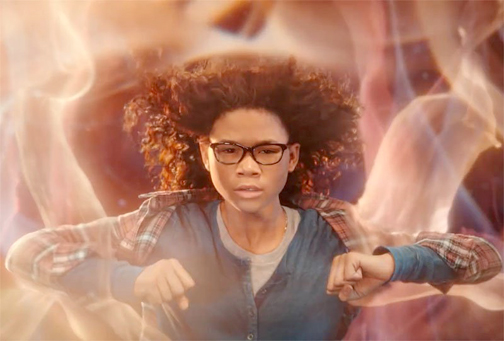Disney’s next great fantasy adventure, “A Wrinkle in Time,” is being released on the heels of its Marvel blockbuster “Black Panther.” Like its boffo box office predecessor, the film is gorgeous to look at but, unlike the important cultural shift signaled by “Black Panther,” beneath this movie’s scenery there isn’t much there.
Adapted from the popular children’s book by Madeleine L’Engle, with a screenplay by Jennifer Lee and Jeff Stockwell, the film is presented in candy-colored CGI wrappings adorned with star-studded ribbons and contains clever visuals and breathtaking intergalactic vistas. Just don’t expect too much enthralling storytelling.
Directed by the groundbreaking Ana DuVernay and anchored by the strong female presence of Oprah Winfrey, Reese Witherspoon and Mindy Kaling as Mrs. Which, Mrs. Whatsit and Mrs. Who, the movie should have hit it out of the box. But it doesn’t. Full disclosure: This reviewer has never read the book, but whatever nuances L’Engle created in her story are sadly lacking on screen.
The movie opens with the daughter of two brilliant scientists, a little girl named Meg Murry (Storm Reid), working with her father on his theories of space travel. Mr. Murry (a furry Chris Pine) believes that space travel is possible through a geometrical entity called the tesseract, which, if used properly, can create a fold or wrinkle in the space-time continuum that allows the traveler to leap billions of light years away. Naturally Murry is laughed at by his peers and just as naturally one day he suddenly disappears. No prizes for guessing what happened.
Jump four years later and Meg is a sad-sack student being bullied at school, supported only by the love of her little brother Charles Wallace (Deric McCabe), and the admiration of an attractive fellow student, Calvin (Levi Miller). Unknown to Meg, Charles Wallace has made friends with three very strange women, the above-mentioned Misses, and he introduces them to her explaining that they are going to help find their father. The only explanation for the three is that they are the “Universe.” Oprah tells Meg she must be a warrior. Apart from finding her missing father, it isn’t really clear what kind of warrior Meg is expected to be.
From here the story follows a familiar path: good will battle evil to a foregone conclusion. Love will prove to be power, and lessons will be learned about trusting in oneself. Author L’Engle had a fraught relationship with Christianity and her contention that evil is an actual physical force in the universe and mankind is its unwitting victim seems to absolve mankind from any responsibility for human actions. The movie’s evil is named “It.” It inhabits the planet Camazotz in the same way the Eye of Sauron hovered over Mordor. It also appears to be a close relative of Credence Barebone’s Obscurus in “Fantastic Beasts and Where to Find Them.” And this is the problem. Apart from setting up Meg’s choices for rescuing her father, something that never really seems in doubt, there isn’t much else going on.
In the end the three children are nothing more than ciphers not fully rounded characters, like say Harry, Ron and Hermione. As hard as they try, Meg, Calvin and, to a lesser extent, Charles Wallace have little to do but react to the CGI images that appear on the green screens behind them. Meg is bright, Charles Wallace brighter, and Calvin is empathetic and good-looking. End of story and, sadly, a missed opportunity for real on-screen magic.
See you at the movies!

